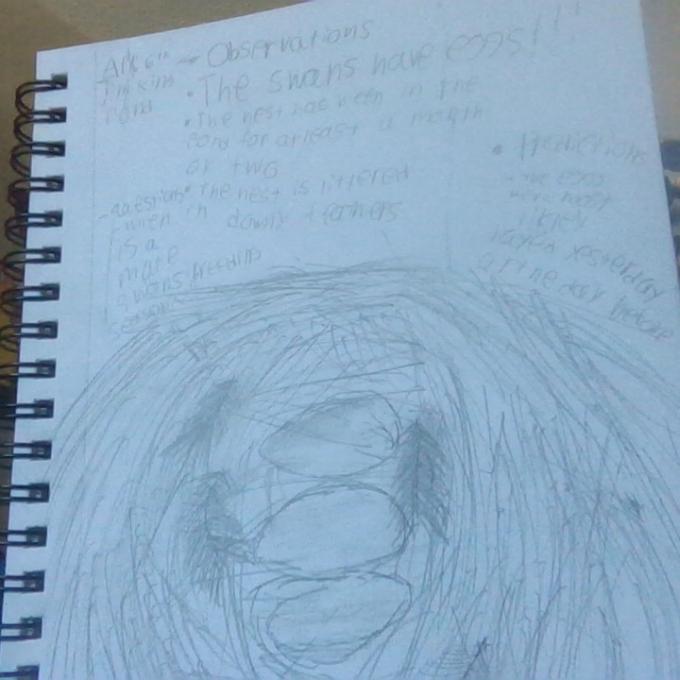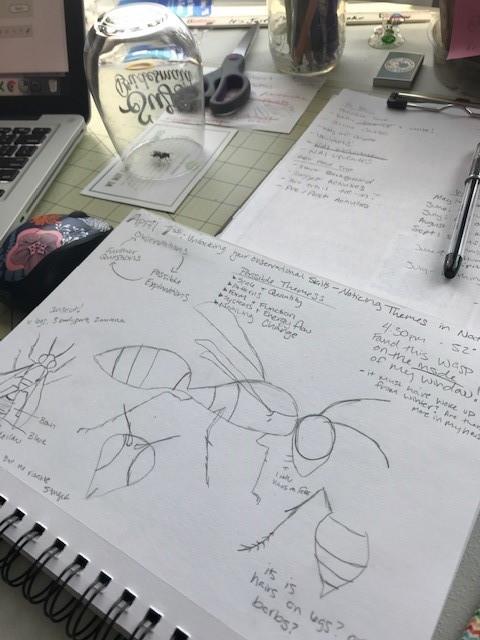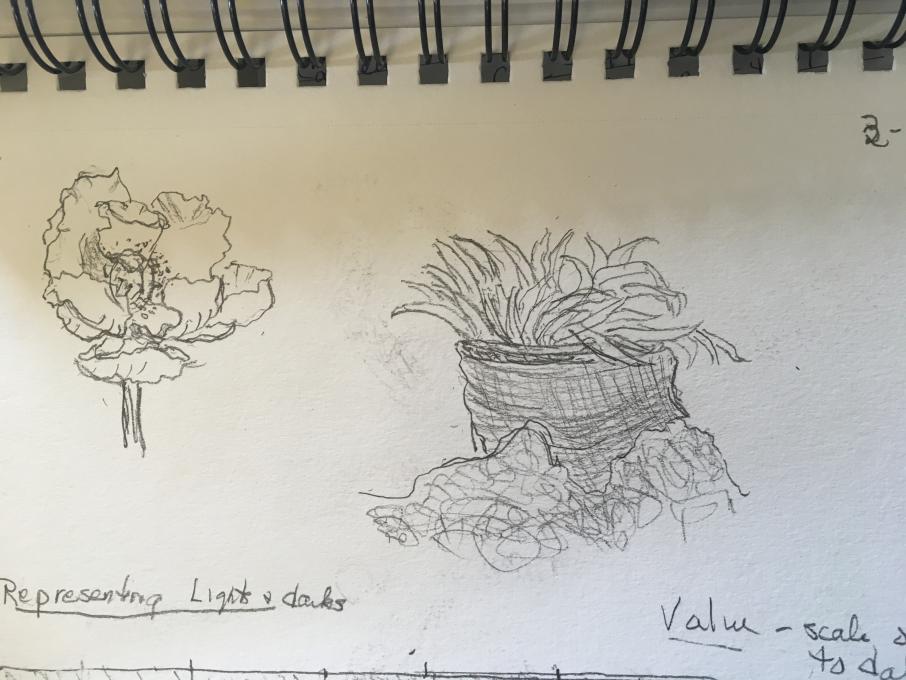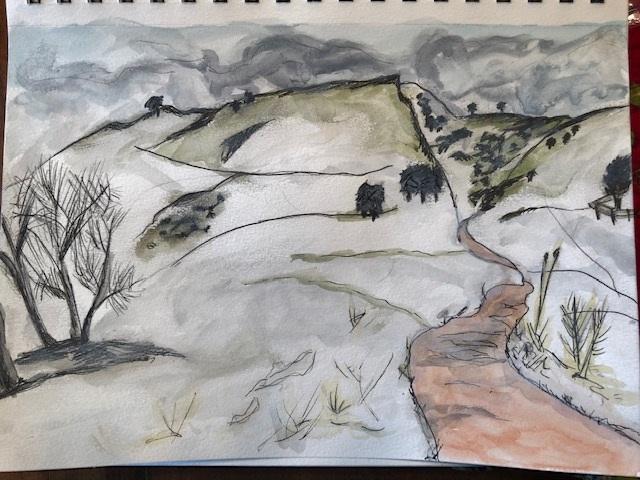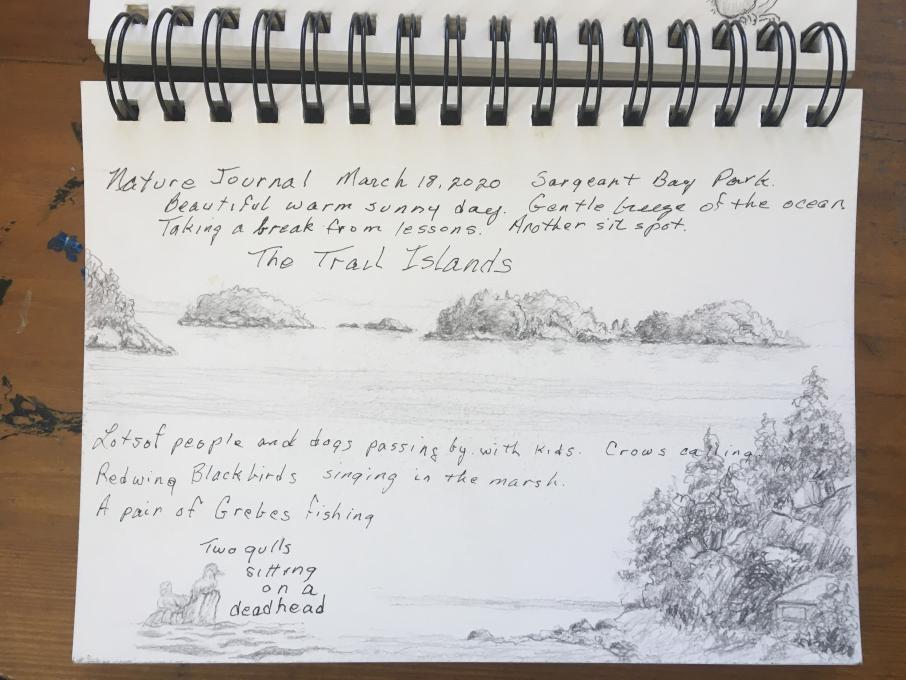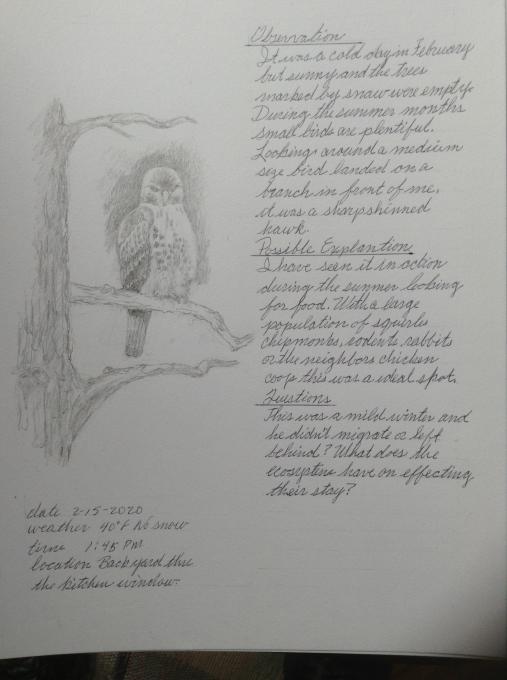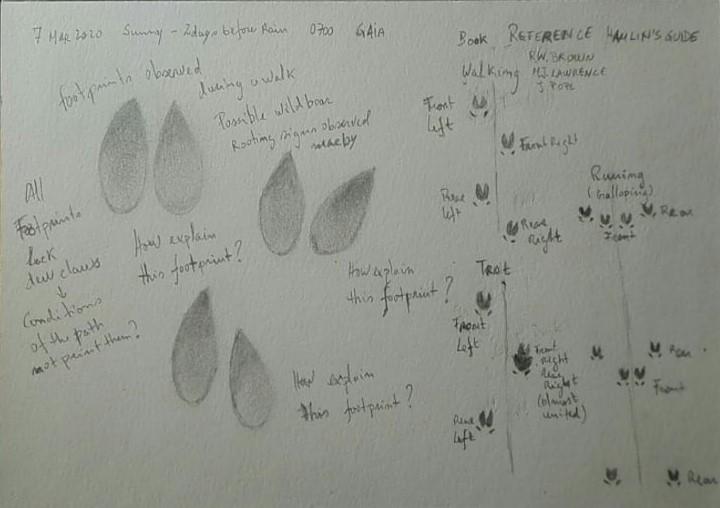The Cornell Lab Bird Academy › Discussion Groups › Nature Journaling and Field Sketching › Noticing Themes in Nature
-
I have done a walk and I observed the different types of trees and colours. They have different shapes and roots and I would like to learn how to draw the roots of the trees. By reflecting on the scale and quantity, there are many, some areas have lots of trees. I have reflect upon my students and their learning. They come to University to study, we treat them equally, but the reality is that - as the trees - they are very different to each other, they have different lights and dimensions. Therefore, they will not have the same learning experience. Forms: the forms of the trees are very different and their leave might have different colors too even if they are the same trees.

-
Hi, Stefania. What a happy picture. I love your dog! And the snails . . . they’re my favorite! 🐌🐌
-
-
 Pattern around flower center *might* become the top of the seedhead. Sawtooth leaves. Flower opened today and hairy bud covering fell to the ground. Different life stages...bud, flower open, later followed by seedhead. Reading about the plant made me decide to dig it up and replant it with more compost so it has better drainage. It is such a dramatic flower.
Pattern around flower center *might* become the top of the seedhead. Sawtooth leaves. Flower opened today and hairy bud covering fell to the ground. Different life stages...bud, flower open, later followed by seedhead. Reading about the plant made me decide to dig it up and replant it with more compost so it has better drainage. It is such a dramatic flower. -
Beautiful vibrant colors! I am drawn into the magic of your page by your lively and charming poppy. I want to dance with it!
-
Love your page! I will aspire to this level of wonder!
-
Color is great here.
-
-
I did a skull comparison of a prairie dog and rabbit of their size and observations about the teeth.

-
I love that! Well done, I’ll definitely try to sketch the next deer skull I run across!
-
Bones: excellent place to start.
-
-
One of my favorite things about keeping a nature journal has been allowing myself the time to observe closely tiny events in nature...either in my backyard, at the beach or on a hike in the woods. My goal each time I make a new journal entry is to observe something I would otherwise have not noticed, either by overlooking it or simply not taking the time to look slowly and closely. This always leads to so many questions that I am following up with -- also more observations, as well as a rabbit hole of research. So rewarding and fun! The journal entry I am including here is of bees in my garden -- I noticed many patterns: in behavior (ie, small groups of my garden honey bees seem to stay around foraging in their own distinct Geranium clumping the garden (see map in my journal) and they seem to be able to make immediate decisions about whether they will dive headfirst into the flower for nectar or move on to the next flower straight away (I timed many of these "flower stops"; form and function (of the lovely Geranium flower design for attracting bees as pollinators, the bees' body and leg designs for pollen gathering and so much more!; patterns of change throughout the garden as spring deepens and more types of
 flowers and leaves begin opening up. This observation day led to so many questions (and even a few answers!).
flowers and leaves begin opening up. This observation day led to so many questions (and even a few answers!). -
I was listening to a podcast recently (possibly BBC Inside Science??) which said that they thought that when a bee visits a flower it changes the electrical charge in the flower. The next bee can sense the change and knows that the flower has already been visited. Which is pretty amazing. 🙂
-
-
The sketch below shows the trials of nesting season. A pair of redwing blackbirds have a nest in the lake grass along the shoreline. I constantly see one of the blackbirds, male I'm assuming, chasing a crow away. The crow keeps coming back and the blackbird has to expend so much energy chasing the crow! Then one morning, there was a turkey vulture there. I wondered if the eggs or hatchlings were destroyed. But the little blackbird chased away this huge vulture. The vulture did not come back but the crow is around. Daily, for over a week, the blackbird chases the crow. I wonder if any survived in the nest, and if not, whether another clutch of eggs was laid. There is still something there to protect.
-

-
 “
“ -
On April 9, I came across a "crime scene" on a snowy trail in Moosehorn WR in Maine. Feathers were scattered on the trail. I was not sure about the identities of the prey or the predator. Woodcocks had been displaying for about a week, and the feathers looked as if they could have belonged to a woodcock, so that was my hypothesis. I sketched a few feathers, then looked for and found the bill which was very long and oddly shaped at the end - certainly a woodcock. None of the feathers were broken. They appeared to have been neatly plucked. I imagine a mammal would have been messier, breaking feathers or leaving feathers in clumps, so a hawk or owl was most likely the predator. I looked for signs of an owl's roost but didn't find anything, so I really don't know. It was fun to play detective and look more closely to try to solve a mystery.

-

 Noticing - Form & Function. On a recent walk at our local wildlife refuge, I noticed two large patches with multiple 1” holes in the sand, as seen in the photos above. It was startling to see all these holes along the paths, and me wonder who made them and whether both patches were made by the same creature. The refuge has lots of fire ants and also lots of Lubber grasshoppers (who hatch from the ground in early spring) at this time of year, so I guessed that these holes were homes to one of them. But when I looked up ‘ant holes’, I made a fascinating discovery - these crater-like pits appear to be the engineering feat of Antlion larvae, known to be voracious little predators. I remembered learning years ago about how Antlion larvae hide in wait and feed on ants and other insects that fall into their traps. What an ingenious design! I also discovered that these insects are sometimes called Doodlebugs, because of the winding, spiraling trails they make in the sand when they emerge from their pits!
Noticing - Form & Function. On a recent walk at our local wildlife refuge, I noticed two large patches with multiple 1” holes in the sand, as seen in the photos above. It was startling to see all these holes along the paths, and me wonder who made them and whether both patches were made by the same creature. The refuge has lots of fire ants and also lots of Lubber grasshoppers (who hatch from the ground in early spring) at this time of year, so I guessed that these holes were homes to one of them. But when I looked up ‘ant holes’, I made a fascinating discovery - these crater-like pits appear to be the engineering feat of Antlion larvae, known to be voracious little predators. I remembered learning years ago about how Antlion larvae hide in wait and feed on ants and other insects that fall into their traps. What an ingenious design! I also discovered that these insects are sometimes called Doodlebugs, because of the winding, spiraling trails they make in the sand when they emerge from their pits! -
As a field biologist, most of my work consisted of looking out for specific behaviours. So much that sometimes I forget I don't know everything and some themes are foreign to my scientific comprehension. This class has taught me again the value of asking questions, and the beauty behind it, instead of simply 'knowing' the answer.
-
Well, I tried your spot sit that you suggested plus still doing my birdsitting out back as well. I think I will drive down next time. I packed my items I wanted to carry in my Audobon field type bag. I have a folding stool so with that in tow and my camera I headed down to the woods edge where a creek flows through close to the woods. The area has a closed sign due to the virus thing. So I just sat by the edge near the roadside. Was a great experience but shorter than I had planned as needed to run back home. That's why I said perhaps I should drive down so no need to rush right back home. I have written my notes and thoughts and sketches in my sketchpad to share.

-
Sit spot, back yard, small town, eastern NC April 10, 2020 Mid morning theme; changes Observation/ The poor little rhododendron has healthier, more abundant blooms than the first and second spring after it was planted. Explanation possibilities: the roots are more established; the soil is becoming more fertile secondary to leaf fall, time, ; the rhododendron is responding positively to the wet winter; warmer winters are advantageous to its' growth. Questions / Will the rhododendron ultimately thrive in its' current location? Will foliage improve over the spring and summer? Will it actually grow? What modifications would be beneficial beyond leaving the plant site to natures' cycles?
-
I am, the swans that live not to far from our house now have eggs!

-
As a biology teacher, I have for years emphasized the relationship between form and function. We start with simple examples, like the human hand. Then we revisit it throughout the year, whether we are studying the fit of a species in its environment, the structure of the digestive system, or the shape of an individual protein, like ATP synthase in our mitochondria. I love the idea of revisiting the same sit spot regularly over the course of a year to watch for change over time.

-
Oops... I mislabeled my specimen... I got the bushes in my yard confused. This isn't Mountain Laurel, it is Andromeda. The variety is Pieris Mountain Fire.
-
@Matt Hi, Matt. I have this pretty tree in my front yard and did not know it’s name. Now, I say, “Good Day, Andromeda,” when I pass it. Thanks for the teaching moment. Love your drawing.
-
-
I found that I naturally think for form and function as a theme. I found this wasp on the inside of my window. Not super pumped that it is indoors but it was a perfect chance to journal! I looked at body parts and thought why would they be that shape, why does this wasp have hairs or barbs on its legs. That led me to think of its behavior. Why is it rubbing its legs like that?


-
I think that I'm starting to recognize some of the "themes" in nature more often, but I would like to improve on seeing them more easily. I think if you can recognize themes easily, you can see unique things about different plants and animals to make them more distinguishable.
-
It has been pretty cold here in Colorado and I haven’t started doing much walking out yet so I did some drawing that were presented in our course just as practice exercises. Can’t sit outside for long and the higher country still has too much snow. I am so looking forward to taking my sketchbook up a high meadow very soon to sketch some of the beautiful wild flowers we have here. Some birds are here already. Need to take some pictures are draw from them “inside”. April should be better.


-
this topic was very useful to me as a biologist always wondering WHY?
-
At this time of year, I enjoy seeing the patterns of the leaves on the ground that fell last fall. There are different colors, the curves or the points of leaves. Some of the leaves are darker than others, and the fact that they aren't crunchy anymore and as the light filters through the still bare trees it makes for an interesting blanket on the forest floor.
-
Patterns of behavior. Here in south-eastern Australia , on our property, the Australian Wood Duck (not related to the American Wood Duck) bred several months ago and birds are now congregating into larger groups. However this week a pair with one small duckling is in our yard. Question 1. Is this early breeding for next season or late breeding for the last? According to references, in south eastern Australia breeding season is July to October, but up to December whereas in north eastern New South Wales it is December to April but can be all year depending on rainfall and growth of grass. Early clutch size is 10--11 , later clutch size is smaller, averaging 4. Question 2.Are these birds from northern areas rather than locals? Have they left the drier north for the damper south? I will not know the answer to this, but I love looking things up. Comparison by quantity. I know that Australian Wood Ducks are not as numerous this year because I haven't been consciously avoiding stepping on their droppings on the paths and lawns.
-
Yesterday my daughter and I went for a long walk to get out of the house, fresh air and exercise. We have been on Covid-19 lockdown for over a week now. We took the art supplies with us and did landscape drawings. We were inspired by the moody clouds over the mountains at first but the real observations we made during our walk was the transition from winter to spring. There is still snow on the ground, the meadows are boggy with snow melt, making a thick mud that you don't want to get stuck in so we had to stay on the path. The birds were singing and I even saw a big black fly - but he flew away before I could sketch him. Not sure if any of you out there are Gabriel Garcia Marquez fans...but I think this little sketch/painting should be called "Nature Love in the Time of Corona Virus"...

-
Gabriel Garcia Marquez’s book sounds like a good read for this point in life. :) You catch the feeling of the landscape. Thank-you for sharing!
-
I am from Colombia and I love Garcia Marquez books, when I first started reading him I was marveled by his imagination, but when I visited his hometown Aracataca, in the 80's, I realized that what he was describing in his novels was not that far from reality. It was an incredibly experience to walk into the little town with muddy streets to find a procession (It was during the Holy Week) of little white angels running toward the church. The kids were dressed in white tunics with huge paper machè wings, they were barefoot, because they were not allowed to stained their new shoes, that the moms kept in plastic bags to be worn only inside the church. Pigs and dogs were marching alongside the kids toward the tiny church, where the old ladies were dressed all in black getting ready to take dead Jesus around while singing and crying... I could keep writing, but I guess, that is another story. This is a place where magical realism started.
-
@Victoria Wow! What an insight. Thanks for sharing that. I have always loved magical realism. -Linda
-
I think landscape is hard to sketch and I really like what you did here. I will use it as inspiration to sketch my waterscape of Lake Michigan! Great quote. Keep walking!
-
-
An earlier exercise that I reallly enjoyed doing.

-
Beautiful job on the pot of daffodils, Mudito! And your “straight lines” work well with it.
-
-
This is another sit spot day. Went to a beautiful beach up the coast to get out of the house for a while. I have not been able to make the photo thing work for days but today,it worked again. Computers sigh! Anyhow, I continue to work through all the exercises and to enjoy the process. I find I am not so interested in the scientific inquiry portions as I am so focused on drawing. But I do work through them all and find that it does indeed pique my interest and sharpen my observation skills so it is all to the good. I enjoy looking at the work that others are doing and am finally getting a handle on how the submissions thing works.

-
This makes me miss the east coast. :(
-
-
I have leftover items as the result of this lesson.

-
During a walk in a enviromental educational area I came across the track of a wild boar. I assume it was a wild boar since the distribuition of the other ungulates is far, and their number is not increasing as wild boar. Giving a simple justification. Also there were signs of rooting nearby the footprints. To my surprise the dew claws were absent in every footprint, and some asymetric hoof prints were found. This break my mental pattern for the species. I took pictures of those and created an entrance in my journal. I also add a book reference to compare with what I saw. This made me ask some questions that are also visible in the picture.

Read More:
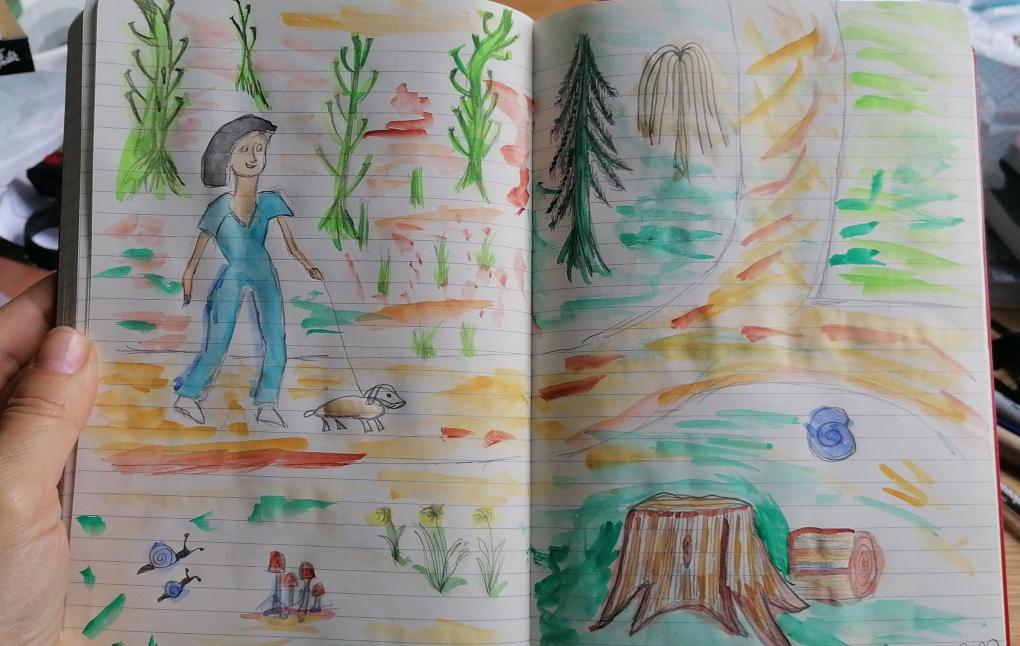
 Pattern around flower center *might* become the top of the seedhead. Sawtooth leaves. Flower opened today and hairy bud covering fell to the ground. Different life stages...bud, flower open, later followed by seedhead. Reading about the plant made me decide to dig it up and replant it with more compost so it has better drainage. It is such a dramatic flower.
Pattern around flower center *might* become the top of the seedhead. Sawtooth leaves. Flower opened today and hairy bud covering fell to the ground. Different life stages...bud, flower open, later followed by seedhead. Reading about the plant made me decide to dig it up and replant it with more compost so it has better drainage. It is such a dramatic flower. 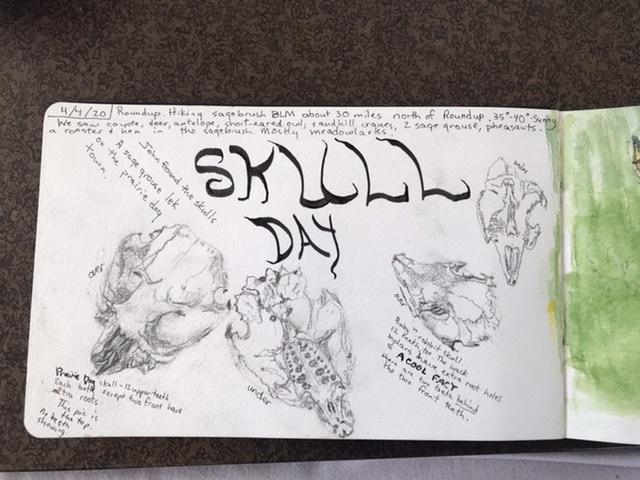
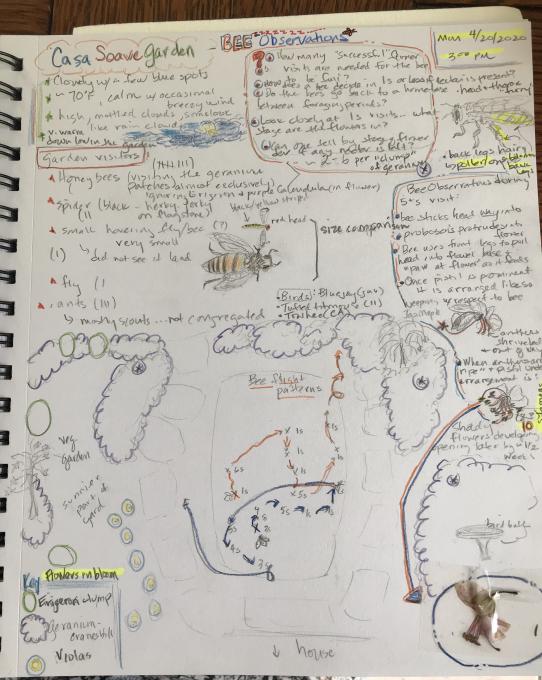 flowers and leaves begin opening up. This observation day led to so many questions (and even a few answers!).
flowers and leaves begin opening up. This observation day led to so many questions (and even a few answers!). 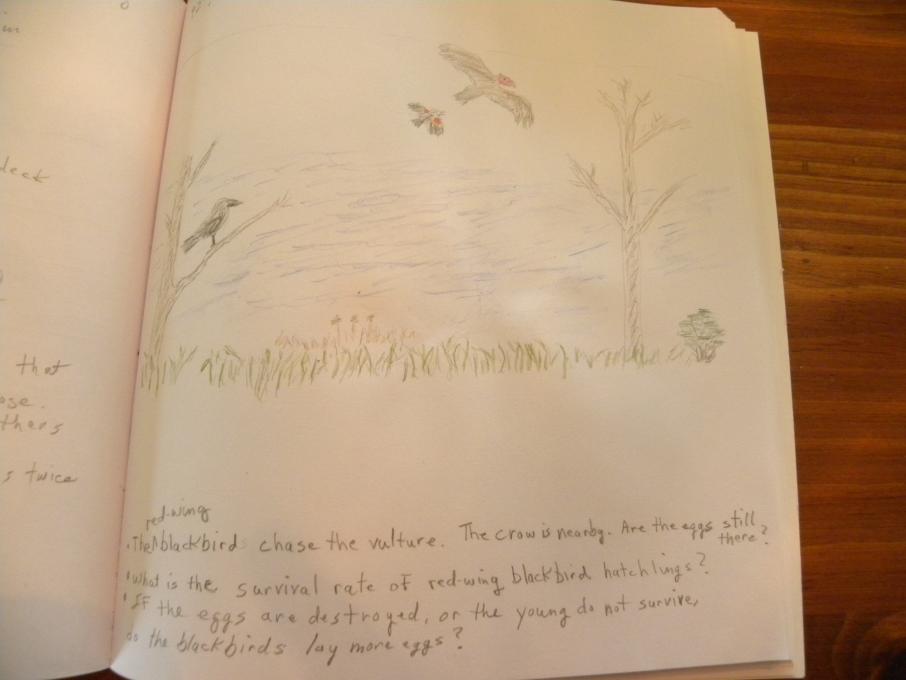
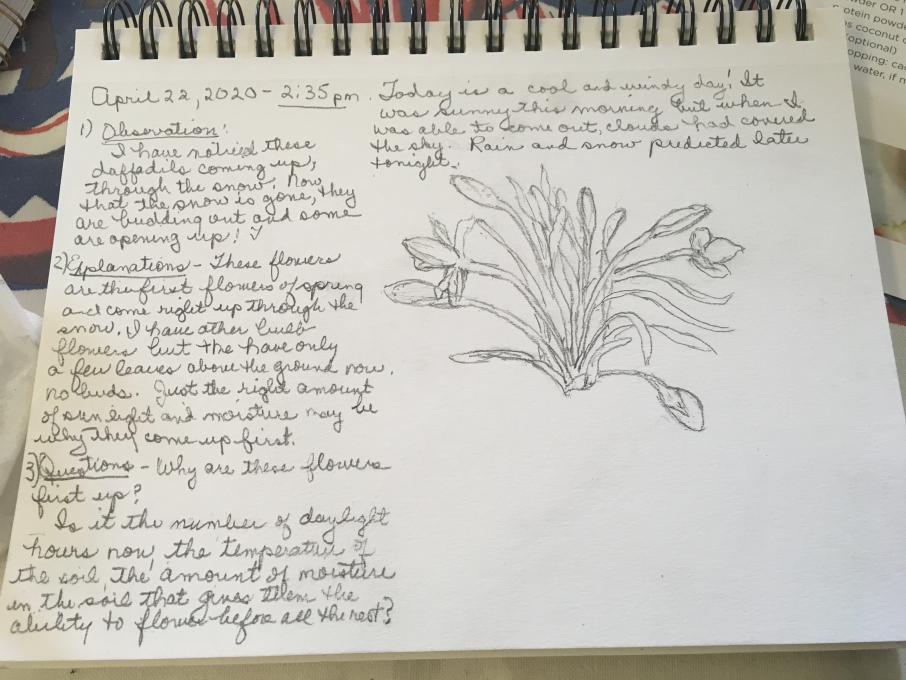 “
“ 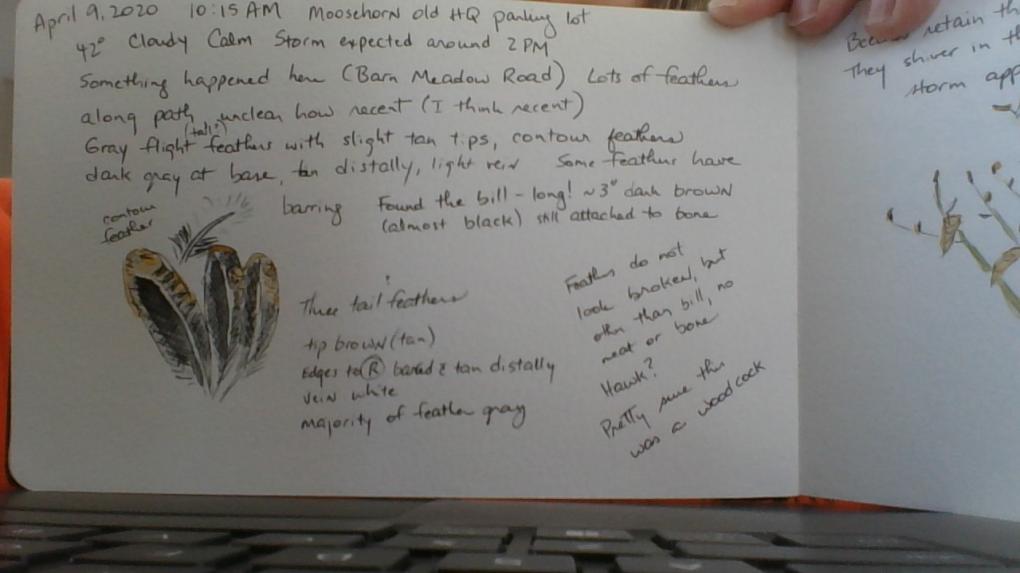

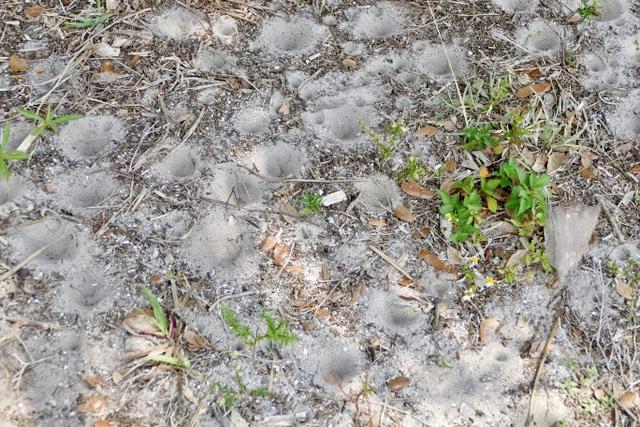 Noticing - Form & Function. On a recent walk at our local wildlife refuge, I noticed two large patches with multiple 1” holes in the sand, as seen in the photos above. It was startling to see all these holes along the paths, and me wonder who made them and whether both patches were made by the same creature. The refuge has lots of fire ants and also lots of Lubber grasshoppers (who hatch from the ground in early spring) at this time of year, so I guessed that these holes were homes to one of them. But when I looked up ‘ant holes’, I made a fascinating discovery - these crater-like pits appear to be the engineering feat of Antlion larvae, known to be voracious little predators. I remembered learning years ago about how Antlion larvae hide in wait and feed on ants and other insects that fall into their traps. What an ingenious design! I also discovered that these insects are sometimes called Doodlebugs, because of the winding, spiraling trails they make in the sand when they emerge from their pits!
Noticing - Form & Function. On a recent walk at our local wildlife refuge, I noticed two large patches with multiple 1” holes in the sand, as seen in the photos above. It was startling to see all these holes along the paths, and me wonder who made them and whether both patches were made by the same creature. The refuge has lots of fire ants and also lots of Lubber grasshoppers (who hatch from the ground in early spring) at this time of year, so I guessed that these holes were homes to one of them. But when I looked up ‘ant holes’, I made a fascinating discovery - these crater-like pits appear to be the engineering feat of Antlion larvae, known to be voracious little predators. I remembered learning years ago about how Antlion larvae hide in wait and feed on ants and other insects that fall into their traps. What an ingenious design! I also discovered that these insects are sometimes called Doodlebugs, because of the winding, spiraling trails they make in the sand when they emerge from their pits! 
